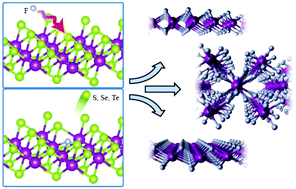Ultra-thin structures of manganese fluorides: conversion from manganese dichalcogenides by fluorination
Abstract
In this study, it is predicted by density functional theory calculations that graphene-like novel ultra-thin phases of manganese fluoride crystals, that have nonlayered structures in their bulk form, can be stabilized by fluorination of manganese dichalcogenide crystals. First, it is shown that substitution of fluorine atoms with chalcogens in the manganese dichalcogenide host lattice is favorable. Among possible crystal formations, three stable ultra-thin structures of manganese fluoride, 1H-MnF2, 1T-MnF2 and MnF3, are found to be stable by total energy optimization calculations. In addition, phonon calculations and Raman activity analysis reveal that predicted novel single-layers are dynamically stable crystal structures displaying distinctive characteristic peaks in their vibrational spectrum enabling experimental determination of the corresponding phases. Differing from 1H-MnF2 antiferromagnetic (AFM) large gap semiconductor, 1T-MnF2 and MnF3 single-layers are semiconductors with ferromagnetic (FM) ground state.

- This article is part of the themed collection: 2021 PCCP HOT Articles


 Please wait while we load your content...
Please wait while we load your content...